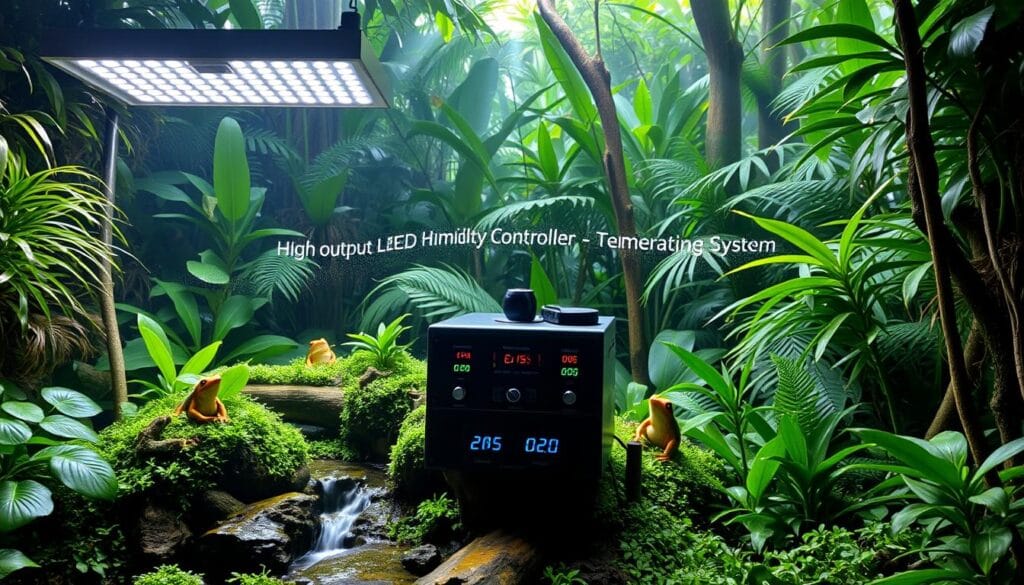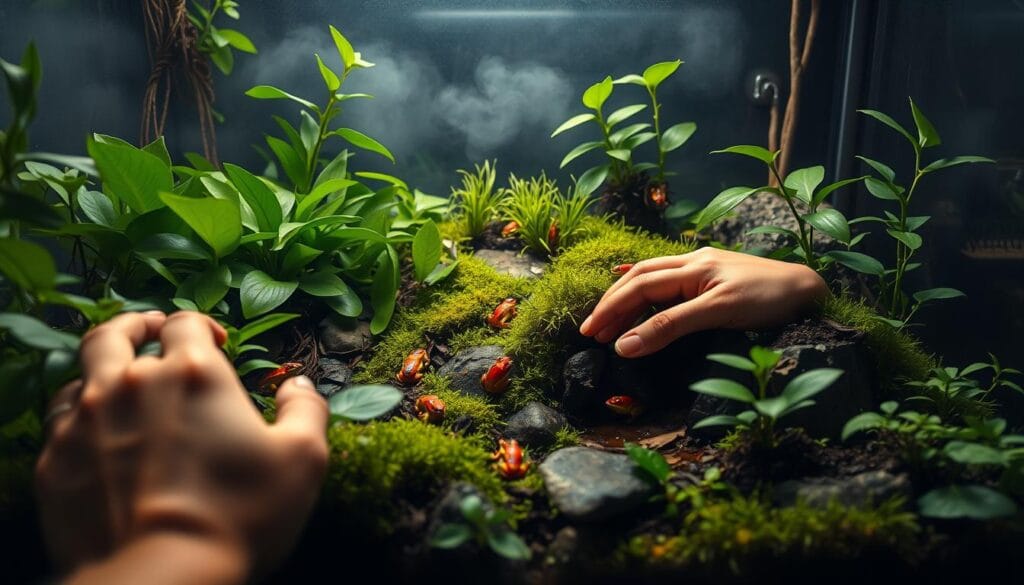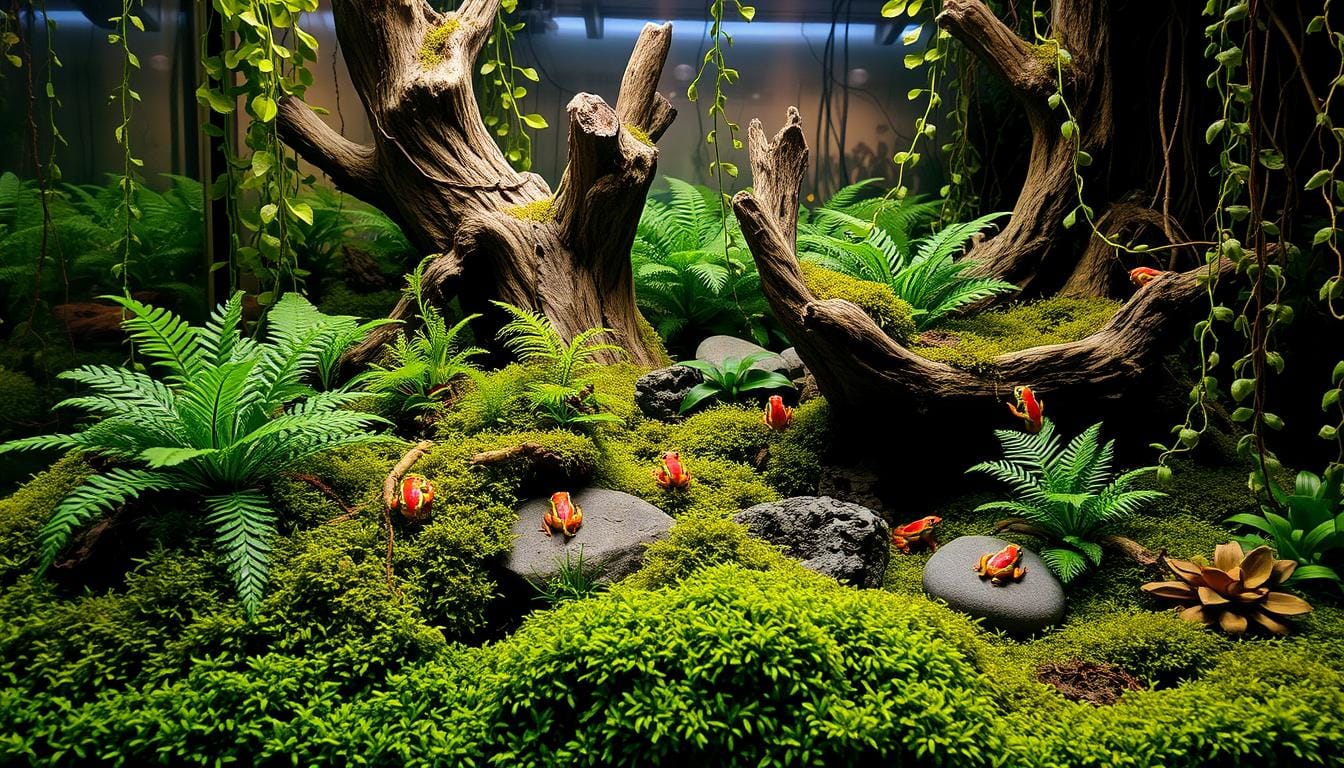When I first saw dart frogs, I was amazed by their bright colors and lively personalities. Setting up a Dart Frog Terrarium became my dream. It turned a simple glass box into a living, breathing world that feels like their natural rainforest home.
Caring for dart frogs is more than just keeping them in a home. It’s about building a tiny world that meets their physical and mental needs. A bioactive terrarium is not just a place to live. It’s a self-sustaining environment that brings the magic of tropical ecosystems into your home.
This guide will show you how to create an amazing dart frog habitat. You’ll learn about their needs and how to design a thriving ecosystem. You’ll discover how to make a terrarium that keeps your dart frogs healthy, happy, and truly stunning.
Table of Contents
Overview of Dart Frogs and Their Habitat Needs
Dart frogs are amazing tropical amphibians that need a special Dart Frog Habitat Setup to live well in captivity. These colorful creatures need careful attention to their environment. This makes them a special pet for those who are really into it.
It’s key to know what Dart Frog Tank Requirements are for a good habitat. These small but interesting creatures come from tropical rainforests. So, it’s important to make their home like their natural one for their health and long life.
Understanding Dart Frog Species
Dart frogs have many species with different traits. Let’s look at some important facts about the Dendrobates leucomelas:
- Care Level: Easy for experienced terrarium keepers
- Size Range: 1.5 to 2 inches
- Lifespan: Potentially 10-20 years in captivity
- Optimal Temperature: 70-80°F (21-27°C)
Importance of a Bioactive Environment
A bioactive environment is like the frog’s natural home. It’s a complex and lively habitat. This setup helps the frog’s body and mind by making a living terrarium.
Ideal Climate Conditions
| Climate Parameter | Recommended Range |
|---|---|
| Humidity | 80-100% |
| Daytime Temperature | 75-80°F |
| Nighttime Temperature | Low 70s°F |
| Lighting | 12-14 hours daily |
By watching and keeping these specific conditions, you can make a perfect home for your dart frogs. This will help them stay healthy and happy.
Essential Supplies for Your Terrarium
Setting up a terrarium for your dart frogs needs careful planning. You’ll need Dart Frog Terrarium Supplies and Dart Frog Tank Accessories. A good terrarium is more than a container. It’s a home that meets your frog’s needs.
Terrarium Choice: Glass vs. Acrylic
Choosing between glass and acrylic terrariums is important. Glass terrariums are clear and hard to scratch. Acrylic ones are lighter and safer from impacts.
- Glass Terrariums:
- Crystal-clear visibility
- More scratch-resistant
- Heavier and more fragile
- Acrylic Terrariums:
- Lightweight design
- Better impact resistance
- Potential for slight visual distortion
Substrate Options for Dart Frogs
Choosing the right substrate is key for a healthy terrarium. Look for materials that keep moisture and support good bacteria.
| Substrate Type | Benefits | Recommended Use |
|---|---|---|
| Coconut Fiber | Excellent moisture retention | Primary substrate layer |
| Sphagnum Moss | High water retention | Top layer and humidity control |
| Orchid Bark | Provides drainage | Bottom layer of terrarium |
Plants That Thrive in Dart Frog Terrariums
Choosing the right plants is important for a thriving terrarium. Pick plants that like high humidity and grow well in different heights.
- Recommended Plants:
- Bromeliads
- Pothos
- Ferns
- Miniature Orchids
“A well-designed terrarium is a living, breathing ecosystem that mimics the natural habitat of dart frogs.”
Designing Your Dart Frog Terrarium Layout
Creating a dart frog enclosure needs careful planning and creativity. Your terrarium should look like their natural home. It should also be beautiful and functional for them.
When designing your dart frog tank, focus on these key elements. They turn a simple habitat into a unique ecosystem:
Strategic Terracing for Visual Interest
Terracing adds depth and dimension to your enclosure. Use these ideas to build a multi-level landscape:
- Incorporate cork bark backgrounds for vertical texture
- Create graduated elevation using natural substrate
- Position rocks and driftwood to form distinct levels
Maximizing Vertical Space
Dart frogs love to climb, so use vertical space well. Your tank decor should include:
- Tall bromeliads for climbing
- Vertical cork bark pieces
- Strategically placed branches
Essential Hiding Spots
Make sure your dart frogs have safe places to hide. Hiding spots are key for reducing stress and mimicking their natural environment. Good options are:
- Small cave-like structures
- Dense plant clusters
- Overlapping leaf formations
By designing your terrarium with these ideas, you’ll make a lively, functional home. It will support your dart frogs’ physical and mental health.
Setting Up the Bioactive Ecosystem
To make a Dart Frog Vivarium Design work, you need to plan well. It’s all about creating a self-sustaining environment. This setup should look like their natural habitats.
A bioactive terrarium is more than a home. It’s a balanced ecosystem. You must have layers for plants, microorganisms, and your dart frogs’ needs.
Introducing Live Plants
Choose plants that fit your dart frogs’ world. Good picks include:
- Bromeliads for water collection
- Moss species for moisture retention
- Small ferns for ground cover
- Miniature orchids for vertical interest
Adding Cleanup Crew Inhabitants
Microfauna is key for balance in your ecosystem. Good cleanup crew members are:
| Species | Function | Quantity per Enclosure |
|---|---|---|
| Springtails | Decompose organic matter | 100-200 |
| Dwarf White Isopods | Break down leaf litter | 50-100 |
Creating Ecosystem Layers
Design your terrarium with layers for drainage and nutrient cycling:
- Drainage Layer: Use hydroton pebbles or expanded clay
- Substrate Barrier: Fine mesh screen to separate layers
- Bioactive Substrate: Organic mix of coconut coir, bark, and soil
- Leaf Litter: Oak or magnolia leaves for decomposition
With these steps, your dart frog vivarium will be a thriving, easy-to-care-for ecosystem. It will support your amphibian friends’ health and natural behaviors.
Selecting the Right Lighting
Creating the perfect lighting environment is key for your dart frog tank. The right light supports plant growth and keeps your dart frog healthy. Lighting is vital for your terrarium’s delicate ecosystem.
Choosing the right lighting for your dart frog habitat is important. Different lights can greatly affect your terrarium’s environment and your frogs’ health.
Lighting Types: Choosing the Best Option
- LED Lights: Recommended for their energy efficiency
- Fluorescent bulbs: Provide consistent illumination
- Incandescent lights: Less popular for dart frog habitats
Understanding Light Cycles
Dart frogs do best with light patterns that match their natural habitat. A good light cycle includes:
- 12 hours of light
- 12 hours of darkness
UVB Lighting Considerations
UVB lighting is a topic of debate among dart frog fans. Some use it to help with Vitamin D3, but it can stress some species. This is true for Dendrobates pumilio and D. auratus, which prefer less light.
When picking dart frog tank accessories, look for terrarium lighting that keeps humidity right. LED lights are great because they don’t get hot and help keep your terrarium stable.
Pro Tip: Always monitor your terrarium’s environment closely when introducing new lighting systems.
Maintaining Humidity and Temperature

Creating the perfect environment is key for dart frog care. These delicate amphibians need specific climate conditions to thrive. Knowing their humidity and temperature needs is vital for a healthy home.
Dart frogs are sensitive and need careful environmental conditions. Their survival depends on balanced temperature and humidity levels.
Humidity Control Techniques
Keeping humidity levels right is essential for dart frog care. Here are some ways to manage moisture:
- Use an automatic misting system for consistent humidity
- Place water bowls near warm areas to increase evaporation
- Install small waterfalls to enhance ambient moisture
- Utilize natural wood decorations that retain moisture
Temperature Monitoring Equipment
Reliable temperature control needs good monitoring tools. Get digital thermometers with humidity sensors to track conditions accurately.
| Temperature Range | Recommended Settings | Time of Day |
|---|---|---|
| Daytime Temperature | 70-80°F (21-27°C) | Active Hours |
| Nighttime Temperature | 60-70°F (15-21°C) | Resting Period |
Seasonal Adjustments for Comfort
Different seasons need small changes in the environment. Use heating mats or ceramic heat emitters during colder months to maintain consistent temperatures. In summer, ensure proper ventilation and avoid direct sunlight.
Remember, dart frog care is an ongoing process. Regular monitoring and gentle adjustments will keep your amphibian friends healthy and happy.
Feeding Your Dart Frogs
It’s important to feed your dart frogs right to keep them healthy. Knowing what they need helps you take good care of them.
Diet Basics: Insects and Nutritional Needs
Dart frogs love to eat small insects. In their terrarium, they need:
- Fruit flies (most common food source)
- Springtails
- Pinhead crickets
- Bean beetles
- Termites
Frequency of Feeding
Adult dart frogs need to eat 2-3 times per week. Each time, give them different insects for a balanced diet. Experts say:
- Give them various insects
- Dust insects with calcium
- Watch how much you feed them
“A diverse diet is key to maintaining your dart frog’s health and vitality.”
Special Considerations for Juveniles
Young dart frogs eat differently. They need to eat every day with small amounts. They also need extra calcium during this time.
For when you’re away, here’s what to do:
- Use automatic misting systems
- Seed vivarium with more microfauna
- Prepare older fruit fly cultures for slow-release feeding
By following these feeding tips, you’ll make a great home for your dart frogs in their terrarium.
Health Considerations for Dart Frogs
Dart frog care is all about watching their health closely. These tiny amphibians need special care to stay healthy in their homes. This is key for their long-term survival.
Common Health Issues and Warning Signs
Knowing about health problems is important for dart frog owners. Look out for these warning signs:
- Unusual lethargy or reduced movement
- Skin discoloration or unusual texture
- Breathing difficulties
- Unexpected weight loss
- Reduced appetite
“Early detection is key to preventing serious health complications in dart frogs.” – Amphibian Specialist
Quarantine Procedures for New Arrivals
When you bring new dart frogs home, follow strict rules. Isolation is critical to stop diseases from spreading:
- Keep new frogs in a separate quarantine area
- Control their environment carefully
- Watch them for 30-45 days before adding them to your collection
- Use different tools for feeding and cleaning
Importance of Regular Veterinary Check-ups
Getting your dart frogs checked by a vet is vital. They can spot and treat health issues early. This keeps your dart frogs healthy in their homes.
Remember, caring for dart frogs is a big responsibility. It means giving them the best home and watching their health closely.
Cleaning and Maintenance Routines

Keeping a dart frog terrarium healthy is all about balance and gentle care. Your bioactive dart frog habitat setup needs special maintenance to keep the ecosystem in check.
Frequency of Terrarium Maintenance
Regular upkeep is key to a thriving dart frog terrarium. Here are important tasks to do:
- Mist the enclosure daily to keep humidity at 70-100%
- Remove uneaten food within 24 hours
- Check substrate moisture levels weekly
- Inspect plants and cleanup crew monthly
Best Practices for Cleaning
When cleaning your dart frog terrarium, be gentle to avoid upsetting the ecosystem. Use soft tools and minimal water. Avoid complete substrate replacement, as it can harm beneficial microfauna.
Managing Bioactive Layers
A balanced dart frog habitat setup depends on managing bioactive layers well. Look for these signs of a healthy ecosystem:
- Active springtails and isopods
- Decomposing leaf litter
- Healthy ground cover plants
- No excessive mold growth
By sticking to these maintenance tips, you’ll create a sustainable home for your dart frogs. This will support their health and happiness.
Tips for Breeding Dart Frogs
Breeding dart frogs needs special knowledge and a well-designed vivarium. It’s all about knowing their unique behaviors and needs.
Dart frog breeding is complex and varies by species. With over 170 species, each has its own way of reproducing. This makes caring for dart frogs both interesting and challenging.
Understanding Breeding Behaviors
Male dart frogs are key in breeding. They use special calls to attract females. These calls are unique to each species and are vital for breeding.
- Males typically have smaller, more slender bodies
- Toepads are often larger and heart-shaped in males
- Unique vocalization patterns attract possible mates
Setting Up a Breeding Tank
Creating the right breeding environment is key. Your vivarium should closely match their natural habitat. This includes:
- Maintain humidity levels between 80-90%
- Keep temperatures between 68-80°F
- Provide a 12-hour light cycle
- Offer multiple egg-laying surfaces
Parental Care in Dart Frogs
Some dart frog species show amazing parental care. Females lay 4-10 eggs in special places. Males often help protect and care for the eggs and tadpoles.
Caring for dart frogs during breeding requires patience and attention. By understanding their natural behaviors and creating the right habitat, you can help them through their reproductive cycle.
Troubleshooting Common Issues
Keeping a Dart Frog Terrarium healthy needs careful attention and quick action. Even with a great setup, problems can arise. Knowing how to fix common issues helps keep your terrarium thriving.
Conquering Algae Growth
Algae can quickly become a problem in your dart frog tank. Here are some ways to fight it:
- Reduce direct light exposure
- Improve air circulation
- Introduce more cleanup crew members
- Adjust humidity levels
Managing Unwanted Pests
Pests can upset the balance of your bioactive terrarium ecosystem. Spot and remove pests fast to protect your dart frogs.
| Pest Type | Control Method |
|---|---|
| Mites | Introduce predatory mites |
| Fungus Gnats | Reduce moisture, use sticky traps |
| Springtails | Natural population control |
Adjusting Environmental Variables
Dart frogs are sensitive to changes in their environment. Keep an eye on these important factors:
- Temperature stability
- Humidity levels
- Light cycles
- Substrate moisture
Being watchful and quick to act helps create a stable home for your dart frogs. Remember to make changes slowly to avoid stressing them.
Conclusion: Enjoying Your Dart Frog Terrarium
Creating a dart frog terrarium brings a world of tiny ecosystems into your home. It’s more than a hobby; it’s a chance to care for a delicate, vibrant habitat. These small amphibians, from 0.5 to 2 inches long, add beauty and complexity to your space.
Keeping a bioactive dart frog terrarium helps conservation and teaches you a lot. By choosing captive-bred frogs from trusted sources, you support responsible pet ownership. You can find help and advice from exotic pet communities online.
Embracing Your New Ecosystem
As you explore your dart frog terrarium, remember each one is special. Some places have rules about owning these amazing creatures, so check local laws. Your hard work will pay off with a fascinating look into their world.
Growing Your Knowledge
The dart frog community is full of learning and connection chances. Online forums, local groups, and workshops can improve your care skills. Your terrarium is a living, growing world that inspires and evolves.

